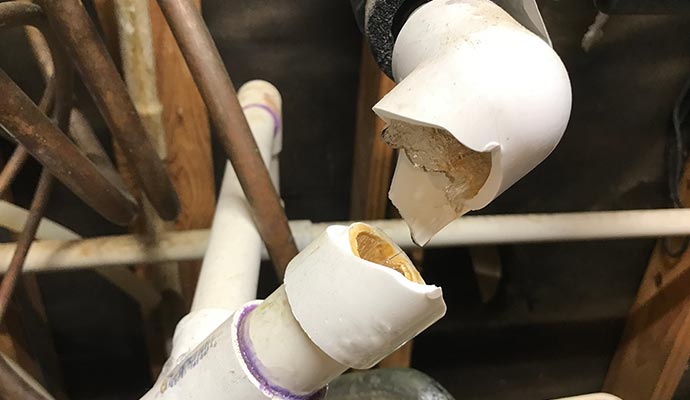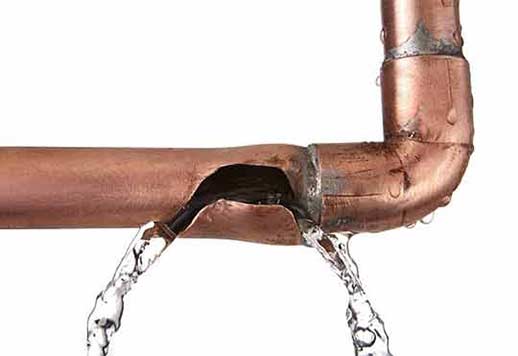Preventing Ruptured Piping: Crucial Tips to Shield Your Pipes
Preventing burst pipelines is an important issue for homeowners, particularly throughout colder months when the risk of cold is increased. Applying tactical actions such as appropriate insulation, regular inspections, and preserving regular interior temperature levels can substantially reduce the probability of pipe failure.
Understand Pipe Vulnerabilities
Comprehending pipeline susceptabilities is necessary for effective plumbing maintenance and preventing costly damage. Numerous elements add to the susceptibility of pipelines to ruptureds, consisting of material composition, age, and ecological problems. Older pipes, specifically those made from galvanized steel or polybutylene, often degrade over time, leading to enhanced threat of leakages and ruptures.
Temperature level fluctuations can additionally considerably effect pipe honesty. In colder environments, water caught in pipes can ice up, increasing and applying pressure on the pipeline walls, which may eventually bring about a ruptured. High water pressure can strain pipes, specifically at joints and bends, enhancing the chance of failure.

Insulate Piping Correctly
Appropriate insulation of pipes is important for protecting against freezing and succeeding ruptureds during winter (burst pipe). Protecting your plumbing system effectively safeguards against temperature level goes down that can result in pricey damage. Begin by recognizing at risk locations where pipelines are exposed to outdoor temperatures, such as cellars, attic rooms, and exterior walls
Usage foam pipe insulation sleeves or wrap insulation tape around these locations to provide a protective barrier. Guarantee that all areas of the pipes, specifically those with minimal warmth exposure, receive adequate insulation. Pay unique focus to joints and installations, as these are extra vulnerable to freezing.
When insulating, it's important to select products that satisfy local building regulations and are ideal for the particular atmosphere. Fiberglass insulation is commonly recommended for its thermal resistance residential or commercial properties. In addition, consider using warmth cords or tape in extreme conditions, which can be plugged in to supply supplemental warm
Regularly check insulated pipes for any indicators of wear or damage, as compromised insulation can lessen its performance. By taking these positive steps, you dramatically reduce the risk of pipe ruptureds, guaranteeing a reputable plumbing system throughout the cold weather.
Maintain Constant Temperature
A steady indoor temperature is crucial for stopping burst pipelines throughout the icy months. When temperatures decrease, water within pipelines can ice up, creating and expanding pressure that may eventually trigger the pipes to ruptured. To alleviate this threat, homeowners must preserve a consistent temperature throughout their home, ideally no reduced than 55 ° F(13 ° C)Utilizing a programmable thermostat can assist manage indoor temperature levels efficiently, guaranteeing that rooms with plumbing remain warm also when your home is vacant. Pay special attention to areas that are extra vulnerable to chilly, such as attics, garages, and basements. Keeping cupboard doors open under sinks can additionally permit warmer air from the home to circulate around pipes.
Additionally, it is prudent to enable faucets to drip slightly throughout severe cool spells. This small circulation of water can protect against cold by alleviating stress within the pipes. During particularly extreme climate occasions, take into consideration briefly putting on hold any nighttime troubles on your thermostat to preserve a consistent cozy atmosphere. By implementing these approaches, house owners can significantly lower the threat of pipe bursts and protect their plumbing systems against the severe winter aspects.
Regularly Evaluate Pipes
Routine examinations of plumbing systems are critical for avoiding burst pipelines and maintaining general home stability. Regular checks allow property owners to determine possible problems prior to they escalate right into pricey fixings or significant water damages. During these evaluations, it is necessary to examine visible pipelines for indications of corrosion, leaks, or use. Pay unique attention to locations prone to cold, such as basements, attic rooms, and exterior walls.
Additionally, examining connections and joints is crucial, as these factors are frequently prone to leaks. House owners must also evaluate water stress levels, as extreme stress can stress the plumbing system and raise the threat of pipeline bursts.
Think about organizing professional pipes assessments a minimum of yearly, especially before winter, to ensure your system is prepared for chillier temperatures. Regular evaluations not only assist in recognizing prompt problems yet additionally foster long-lasting maintenance strategies that can boost the life expectancy of your pipes system. By being proactive in your strategy, you can protect your home against the expensive and disruptive repercussions of ruptured pipes. Focusing on plumbing this content evaluations is a financial investment in your home's health and wellness.
Know Emergency Situation Treatments
Comprehending emergency situation treatments is crucial for every property owner, particularly after performing normal pipes assessments. Being prepared for a plumbing emergency can dramatically mitigate damages and conserve prices.
Next, keep crucial tools convenient. A plumbing emergency kit need to consist of a wrench, bettor, and towels, along with a flashlight and a pail for little leaks. Furthermore, consider having the contact info for a relied on plumbing professional readily offered, ought to the situation intensify beyond your control.
If you detect a leak or ruptured pipe, instantly turn off the water system and directory notify your plumbing technician. Document the damages with photos for insurance policy functions. Know the indications of possible pipes concerns, such as unusual water pressure fluctuations or damp spots on wall surfaces
Ultimately, proactive knowledge and quick action are vital in managing plumbing emergencies, guaranteeing your home continues to be protected and reducing prospective damages.

Verdict
To conclude, stopping ruptured pipes demands a diverse approach that consists of understanding pipe vulnerabilities, appropriate insulation, preserving consistent indoor temperature levels, regular examinations, and expertise of emergency situation procedures. By implementing these important techniques, the risk of pipes failures can be considerably minimized, therefore making certain the longevity and performance of the pipes system. Aggressive measures not just safeguard versus prospective damage but additionally add to total water preservation and the protection of home.
In colder climates, water caught in pipes can freeze, increasing and putting in stress on the pipeline wall surfaces, which may ultimately lead to look at this site a ruptured. When temperature levels decline, water within pipes can ice up, producing and increasing stress that may ultimately cause the pipes to burst. By implementing these strategies, property owners can considerably decrease the danger of pipe bursts and protect their pipes systems versus the harsh winter season elements.
